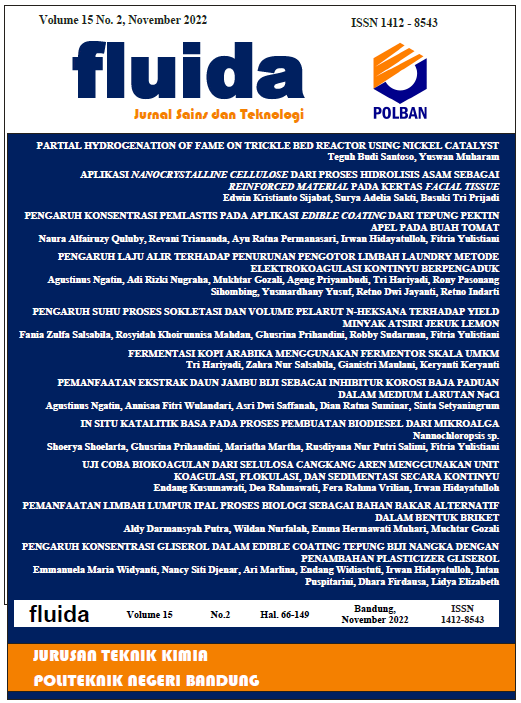Pengaruh Konsentrasi Gliserol dalam Edible Coating Tepung Biji Nangka dengan Penambahan Plasticizer Gliserol
Main Article Content
Abstract
Tomatoes are horticultural plants that are easily damaged, need to be coated with a food grade edible coating. The basic ingredients that can be used are polysaccharides, derived from jackfruit seed flour, then glycerol plasticizer is added to improve the brittle nature of the edible coating. The maximum glycerol added was carried out with the following concentration variations: control (without glycerol), 1.5%, 2.0%, 2.5%. The analysis carried out included testing the respiration rate and weight loss in tomato storage for 6 days. In determining the respiration rate, an experiment was carried out by flowing 1 L/minute of air for 2 minutes which had been passed through a saturated Ca(OH)2 solution flowed into a jar containing tomatoes, passing through a 0.05 N NaOH solution added 0.1% phenophthalein indicator and titrated with HCl 0.05 N until the red color disappears and the weight loss decreases on tomatoes coated with edible coating. The results obtained were the lowest decrease in respiration rate at 2% glycerol concentration of 0.137 mgCO2/kg.hour and the lowest decrease in weight loss at 2.5% glycerol concentration of 1.913%.
Downloads
Article Details

This work is licensed under a Creative Commons Attribution-ShareAlike 4.0 International License.
An author who publishes in the FLUIDA journal agrees to the following terms:
- Author retains the copyright and grants the journal the right of first publication of the work simultaneously licensed under the Creative Commons Attribution-ShareAlike 4.0 License that allows others to share the work with an acknowledgement of the work's authorship and initial publication in this journal
- Author is able to enter into separate, additional contractual arrangements for the non-exclusive distribution of the journal's published version of the work (e.g., post it to an institutional repository or publish it in a book) with the acknowledgement of its initial publication in this journal.
- Author is permitted and encouraged to post his/her work online (e.g., in institutional repositories or on their website) prior to and during the submission process, as it can lead to productive exchanges, as well as earlier and greater citation of the published work (See The Effect of Open Access).
Read more about the Creative Commons Attribution-ShareAlike 4.0 Licence here: https://creativecommons.org/licenses/by-sa/4.0/.
References
[2] M. D. Samman, A. A. Warsyidah, and J. Syarif, “Identifikasi zat lilin pada buah apel yang diperjualbelikan di pasar pabaeng-baeng kota makassar,” J. Media Laboran, vol. 9, no. 2, pp. 1–5, 2019.
[3] M. A. Kenawi, M. M. A. Zaghlul, and R. R. Abdel-Salam, “Effect of Two Natural Antioxidants in Combination with Edible Packaging on Stability of Low Fat Beef Product Stored Under Frozen Condition,” Biotechnol. Anim. Husb., vol. 27, no. 3, pp. 345–356, 2011, doi: 10.2298/BAH1103345K.
[4] A. Valdes, M. Ramos, A. Beltran, A. Jimenez, and M. C. Garrigos, “State of the Art of Antimicrobial Edible Coatings for Food Packaging Applications,” Coating, vol. 7, no. 56, pp. 1–23, 2017, doi: 10.3390/coatings7040056.
[5] S. W. Murni, H. Pawignyo, D. Widyawati, and N. Sari, “Pembuatan Edible Film dari Tepung Jagung ( Zea Mays L .) dan Kitosan,” Pros. Semin. Nas. Tek. Kim. “Kejuangan,” pp. B17-1-B17-9, 2013.
[6] C. Winarti, “et al Teknologi Produksi dan Aplikasi Pengemas Edible Antimikroba Berbasis Pati Jurnal Litbang Pertanian 31, No.3 (2012),” J. Litbang Pertan., vol. 3, no. 3, p. 2012, 2012.
[7] A. Usni, T. Karo-karo, and E. Yusraini, “Pengaruh Edible Coating Berbasis Pati Kulit Ubi Kayu Terhadap Kualitas dan Umur Simpan Buah Jambu Biji Merah pada Suhu Kamar,” J. Rekayasa Pangan dan Pertan., vol. 4, no. 3, pp. 293–303, 2016.
[8] Budiman, “Aplikasi Pati Singkong Sebagai Bahan Baku Edible Coating Untuk Memperpanjang Umur Simpan Pisang Cavendish,” Institut Pertanian Bogor, 2011.
[9] A. Purbasari, E. F. Ariani, and R. K. Mediani, “Bioplastik dari Tepung dan Pati Biji Nangka,” Pros. SNST, pp. 54–59, 2014.
[10] S. H. Ningsih, “Pengaruh Plasticizer Gliserol Terhadap KArakteristik Edible Film Campuran Whey dan Agar,” Universitas Hasanuddin, 2015.
[11] H. M.A, Wignyanto, and I. A. Dewi, “Aplikasi Edible Coating dari KAragenan dan Gliserol untuk Mengurangi Penurunan Kerusakan Apel Romebeauty,” Universitas Brawijaya, 2014.
[12] R. Hasbullah, “Teknik Pengukuran Laju Respirasi Produk Hortikultura pada Kondisi Amosfir Terkendali Bagian I:Metode Sistem Tertutup,” vol. 21, no. 4, pp. 419–427, 2007.
[13] D. Nofriati, Penanganan Pascapanen Tomat. Balai Pengkajian Teknologi Pertanian Jambi, 2018.
[14] R. Amaliyah and S. Kartika, “Pengaruh Konsentrasi Sorbitol dalam Edible Coating terhadap Laju Respirasi, Susut bobot dan Sifat Mekanik Buah Tomat,” Politeknik Negeri Bandung, 2019.
[15] D. Wulandari, E. Ambarwati, D. B. Pertanian, F. Pertanian, and U. G. Mada, “Laju Respirasi Buah Tomat ( Lycopersicon esculentum Mill .) yang Dilapisi dengan Kitosan Selama Penyimpanan The Respiration Rate of Tomato Fruit ( Lycopersicon esculentum Mill .) Coated with Chitosan During Storage,” vol. 11, no. 2, pp. 135–150, 2022.
[16] E. S. Andriani, Nurwantoro, and A. Hintono, “Perubahan Fisik Tomat Selama Penyimpanan Pada Suhu Ruang Akibat Pelapisan Dengan Agar-Agar,” vol. 2, no. 2, pp. 176–182, 2018.
[17] H. F. Siagian, “Penggunaan Bahan Penjerap Etile Pada Penyimpanan Pisang Barangan Dengan Kemasan Atmosfer Termodifikasi Aktif,” Universitas Sumatera Utara, 2009.
[18] N. Hidayah, “Pengaruh Suhu Penyimpanan dan Konsentrasi Pati Lindur (Bruguiera gymnorrhiza) pada Aplikasi Edible Coating Terhadap Kualitas Buah Rambutan (Nephellium lappaceum),” Universitas Islam Negeri Maulana Malik Ibrahim Malang, 2018.
[19] Latifah, “Pengaruh Edible Coating Pati Ubi Jalar Putih (Ipomoea batatas L.) terhadap Perubahan Warna Apel Potong Segar,” Institut Pertanian Bogor, 2009.
[20] P. Picauly and T. Gilian, “Pengaruh Konsentrasi Gliserol pada Edible Coating Terhadap Perubahan Mutu Buah Pisang Tongka Langit ( Musa troglodytarum L ) Selama Penyimpanan The Effect of Glycerol Concentration of Edible Coating on the Quality Change of Banana Fruit Tongkat Langit ( M,” J. Teknol. Pertanian, Agritekno, vol. 7, no. 1, pp. 16–20, 2018, doi: 10.30598/jagritekno.2018.7.1.16.

